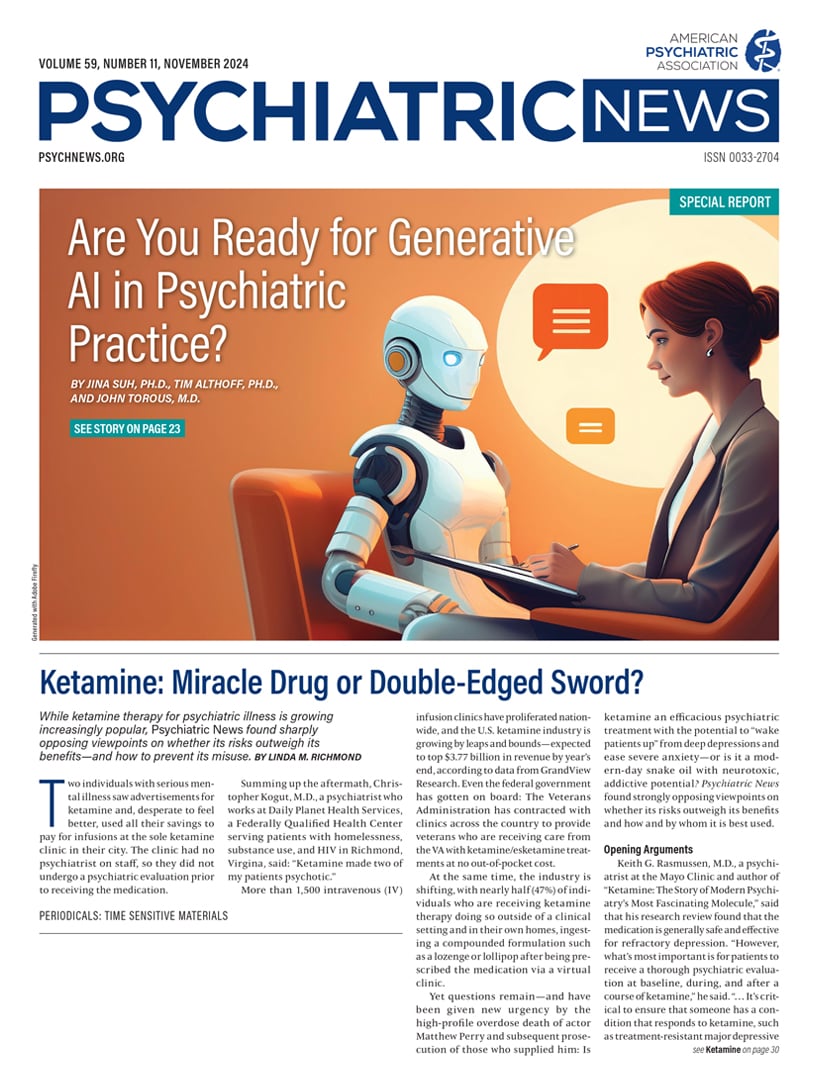Two individuals with serious mental illness saw advertisements for ketamine and, desperate to feel better, used all their savings to pay for infusions at the sole ketamine clinic in their city. The clinic had no psychiatrist on staff, so they did not undergo a psychiatric evaluation prior to receiving the medication.
Summing up the aftermath, Christopher Kogut, M.D., a psychiatrist who works at Daily Planet Health Services, a Federally Qualified Health Center serving patients with homelessness, substance use, and HIV in Richmond, Virgina, said: “Ketamine made two of my patients psychotic.”
More than 1,500 intravenous (IV) infusion clinics have proliferated nationwide, and the U.S. ketamine industry is growing by leaps and bounds—expected to top $3.77 billion in revenue by year’s end, according to data from GrandView Research. Even the federal government has gotten on board: The Veterans Administration has contracted with clinics across the country to provide veterans who are receiving care from the VA with ketamine/esketamine treatments at no out-of-pocket cost.
At the same time, the industry is shifting, with nearly half (47%) of individuals who are receiving ketamine therapy doing so outside of a clinical setting and in their own homes, ingesting a compounded formulation such as a lozenge or lollipop after being prescribed the medication via a virtual clinic.
Yet questions remain—and have been given new urgency by the high-profile overdose death of actor Matthew Perry and subsequent prosecution of those who supplied him: Is ketamine an efficacious psychiatric treatment with the potential to “wake patients up” from deep depressions and ease severe anxiety—or is it a modern-day snake oil with neurotoxic, addictive potential? Psychiatric News found strongly opposing viewpoints on whether its risks outweigh its benefits and how and by whom it is best used.
Opening Arguments
Keith G. Rasmussen, M.D., a psychiatrist at the Mayo Clinic and author of “
Ketamine: The Story of Modern Psychiatry’s Most Fascinating Molecule,” said that his research review found that the medication is generally safe and effective for refractory depression. “However, what’s most important is for patients to receive a thorough psychiatric evaluation at baseline, during, and after a course of ketamine,” he said. “… It’s critical to ensure that someone has a condition that responds to ketamine, such as treatment-resistant major depressive disorder, and to rule out current substance use disorder or psychosis.”
But Paul S. Appelbaum, M.D., Dollard Professor of Psychiatry, Medicine, and Law at Columbia University, is concerned that patients may not be fully informed of the risks and lack of evidence about the off-label use of ketamine in people with psychiatric disorders, on whom the medication has been largely untested. It raises “the question of whether some physicians are ignoring their ethical obligations to patients for their own financial benefit,” said Appelbaum, a past APA president. “... The ethics of many of the practices involving ketamine are in this regard dicey at best.
“They are using it for indications without a good evidence base to suggest that it is likely to be effective, at dosages that are highly variable, in patients for whom it may be contraindicated,” Appelbaum said. “When people talk about a ‘wild, wild west’ situation, they are accurately describing a largely unregulated and out-of-control system that is ketamine.”
Ketamine vs. Esketamine
Ketamine is a racemic mixture that consists of equal amounts of two molecules that are mirror images of one another, esketamine and arketamine. Janssen Pharmaceuticals isolated esketamine to formulate Spravato nasal spray, which was approved by the Food and Drug Administration (FDA) for individuals with treatment-resistant depression in 2019. The following year, the FDA approved Spravato for major depressive disorder with suicidality. Intended to be used in combination with another oral antidepressant in patients with unipolar depression who have failed at least two trials with an antidepressant, the medication is administered only in a specialty clinic under intense pharmacovigilance required by an FDA risk evaluation and mitigation strategy (REMS).
Spravato’s approval is often cited as evidence that ketamine is safe and effective. However, the FDA
cautions that esketamine is not the same product as racemic ketamine. Animal studies have shown that ketamine—but not esketamine—can cause lesions in the brains of rodents; the relevance of this finding to humans is unknown. Furthermore, research shows that esketamine binds more tightly to NMDA (N-methyl-D-aspartate) receptors, allowing patients to take a lower dose of medication than with racemic ketamine.
Ketamine and esketamine both have one major theoretical advantage: They may reduce depressive symptoms or suicidality within hours, at least among a subset of individuals who take them, rather than the weeks or months associated with monoaminergic antidepressants. (For information about patient outcomes using ketamine infusion therapy for treatment-resistant depression at one clinic, see “
Ketamine Infusion Clinic Reports Real-World Patient Experiences.”)
Risks and Benefits
G. Caleb Alexander M.D., M.S., a practicing internist, epidemiologist, and co-director of the Center for Drug Safety and Effectiveness at Johns Hopkins, said there is some evidence that ketamine and esketamine provide short-term relief for treatment-resistant depression. What is lacking is evidence of durability, what happens next, and the risks that the drug imparts.
PubMed shows more than 400 trials of ketamine as a depression treatment in the past decade; however, Alexander said much of that research is plagued by nontrivial limitations, including studies that were too short in duration, had too few participants, were conducted by researchers with conflicts of interest, had no active comparator, or failed to systematically and comprehensively measure safety. The “dealbreaker,” he said, was researcher and participant bias due to lack of blinding.
“When you really carefully examine the quality of the scientific information about ketamine or esketamine and its potential value, the evidence is thin,” Alexander said. Even with FDA-approved Spravato, only one of Janssen’s three Phase 3 esketamine trials demonstrated a statistically significant benefit for treatment-resistant depression at 28 days; its other two trials did not. Even so, the effect size was small—a four-point difference from placebo on the 60-point Montgomery–Åsberg Depression Rating Scale.
“What’s not unclear, what’s not ambiguous [about ketamine], are the potential risks,” Alexander said. “There’s lots of evidence that ketamine is toxic to neurons, and its toxic in a dose- and duration-dependent fashion.
“If you’re talking about giving someone one dose, one time, to knock them out of a truly, profoundly disabling treatment-resistant depression, conceptually, that’s one thing,” Alexander said. “But if you’re administering ketamine to someone who has failed an antidepressant or two, and then repeating the dose week after week for an indefinite period, that’s a different story. Unfortunately, that dosing regimen is not what’s been studied in most of the research.”
Elie G. Aoun M.D., assistant professor of clinical psychiatry at the Center for Law, Ethics, and Psychiatry at Columbia University and author of “
Addiction and the Law,” said that research showing the best outcomes has paired ketamine infusions with psychotherapy involving a therapist specially trained in its use—an expensive proposition for the two-hour treatments.
“That approach is certainly not being practiced right now,” Aoun said. “Most people are simply left in a room by themselves during their infusions, with a technician occasionally checking on them. That by itself is not sufficient.”
One dose of racemic ketamine, decades off patent, costs less than $1, yet patients are typically charged $400 to $900 for a single infusion—substantially higher than a traditional physician appointment, Aoun pointed out. “So, there is certainly a financial incentive to offer this.” Once a ketamine clinic has invested in infrastructure, equipment, and staffing, “then you need to find patients to use it,” he added. “This can lead to a lowering of the diagnostic thresholds.”
Aoun recounted the cases of two individuals who quit psychotherapy, stopped taking antidepressant medications, and have instead been receiving weekly ketamine infusions for the past couple of years. “They’re not doing any better [than when they started], they don’t seem happier or more motivated, they’re not functioning at a higher level,” he said. “… It is creating the illusion for people that there’s a shortcut to feeling better. That’s one of the bigger risks.
“People think that ketamine alone can make you feel better without taking part in psychotherapy, without working to improve your social life, your interpersonal relationships, the way you spend your time, and without thinking about side effects,” Aoun said. “That’s simply not true.”
Marketing and Abuse
The FDA tightly regulates drug manufacturers’ direct-to-consumer advertising, but for the most part, those rules were crafted decades before the advent of telehealth providers and online consumer advertising. Alexander said this has left a loophole that is now being exploited, particularly when it comes to the marketing of ketamine.
Various virtual sites are peddling ketamine as a treatment for nearly everything: panic, posttraumatic stress, anxiety, bipolar spectrum, and substance use disorders, as well as neuropathic pain and restless leg syndrome. One major telehealth provider offers ketamine to individuals who are merely feeling “stuck, trapped, and listless,” according to the company’s website. The provider also states that ketamine works by “fueling neural growth … stimulating neuroplasticity … and fertilizing the brain.”
The FDA issued a
public warning in October 2023 after a woman ingested compounded ketamine lozenges for her posttraumatic stress disorder at home and experienced life-threatening respiratory depression. When she arrived at the hospital, physicians found that her ketamine level was twice the level typically administered for anesthesia.
At the time, the FDA wrote that known safety concerns for ketamine “include abuse and misuse, psychiatric events, increase in blood pressure, respiratory depression (slowed breathing), and lower urinary tract and bladder symptoms.” The warning also emphasized that ketamine is not approved for the treatment of any psychiatric disorder and that the FDA had not determined that it is safe and effective for such use.
Aoun said there is also the risk of abuse. Ketamine is diverted from the commercial supply and sold illicitly for its ability to trigger fast-acting hallucinogenic, outer-body, dissociative experiences users refer to as “K-holes.” Compounded ketamine products heighten this risk because they contain higher concentrations of the drug to overcome its poor oral absorption.
In fact, the sobriety of one of Aoun’s patients—who recently overcame a years-long ketamine addiction—is now at risk after they saw an ad for ketamine lozenges. They told Aoun: “The only thing I can think of is getting a ketamine lozenge, crushing it, extracting it, and using it however I want.”
“With each attempt to make ketamine treatment more accessible and less expensive,” Aoun said, “you’re giving up a little more about what makes it therapeutically successful and increasing the risk of unobserved misuse and diversion.”
Alexander was more blunt, calling the use of take-home compounded ketamine products outside of medical settings seriously midguided. He added: “It’s not just that the product itself is risky, it’s also that it’s being formulated, dosed, and delivered in unsupervised, nonclinical settings.
“How is it that on the one hand, you have Spravato, a product that is subject to one of the most stringent post-approval regulatory monitoring programs the FDA has ever instituted, and on the other hand, you have [ketamine], a product that is nearly identical, being compounded by pharmacists and handed out to people for self-administration in their homes?” he asked. “It defies logic.”
Alexander has studied a handful of rare cases involving individuals who became acutely psychotic and violent following ketamine administration. One of them died after setting himself on fire. He pointed out that the cases are similar to what is often seen in users of a closely related illicit drug: PCP (phencyclidine). Like ketamine, PCP is a fast-acting NMDA antagonist.
As for Daily Planet’s Kogut, his two patients are doing better now. Yet he is shocked by the number of psychiatric trainees he encounters who have a strong interest in providing ketamine and other psychedelic treatments, despite what he says is a lack of scientific rigor surrounding their use. “I hope going forward,” Kogut said, “we as psychiatrists tame our enthusiasm for off-label use of a medication that is unproven.” ■



